
A trailblazer in military satellite communications
The nation's most advanced satellite communications (SATCOM) systems can trace their roots to a pioneering satellite launched 44 years ago. The Lincoln Experimental Satellite-9 proved the feasibility of expanding SATCOM systems into the very wideband, or Ka-band, radio frequency and of incorporating resiliency into communications among mobile users. The technologies demonstrated then now ensure that U.S. commanders can stay connected to their forces worldwide and that civilians can enjoy high-speed communication services.
Now retired in orbit more than 22,000 miles above Earth, LES-9 holds the record for the longest continuously operating satellite in U.S. history, and likely the world.
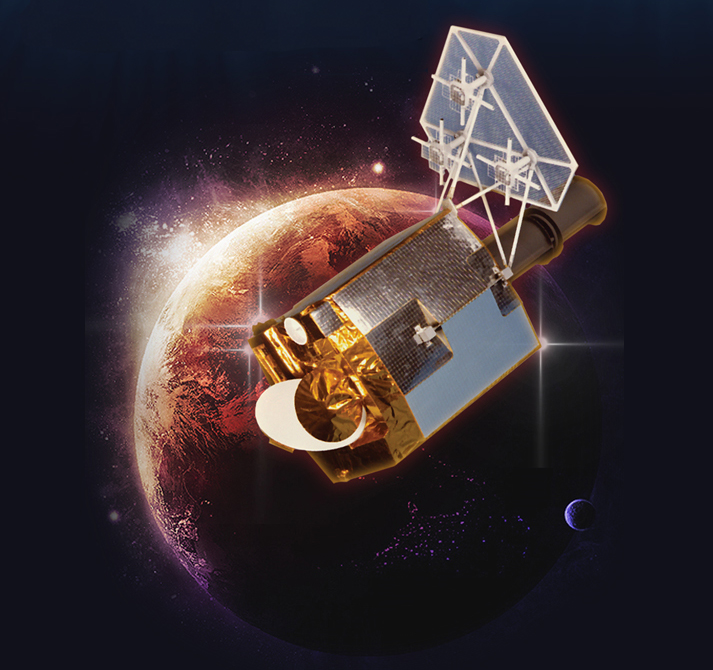
A critical need for robust communications
LES-9 was the last and most technologically sophisticated of a series of Lincoln Experimental Satellites. Running from the early 1960s through the mid-1970s, the LES program and other U.S. development efforts had demonstrated SATCOM technologies for reliable long-range and wide-area broadcast communications. The resulting operational systems — at ultrahigh frequency (UHF) with tens to hundreds of kilohertz (kHz) for mobile users in the range of 225 to 400 megahertz (MHz) and at X band with tens to a few hundreds of MHz for long-haul trunk links in the 7 to 8 gigahertz (GHz) range — provided unparalleled, real-time connectivity to U.S. forces in remote areas.
However, as these systems were coming on line, national studies identified emerging Cold War–era threats that could jeopardize this connectivity in the future. In addition, the existing 1960s systems lacked the bandwidth to support data rates that mobile users would need to accommodate emerging video services and sensor information.
Accordingly, the LES program was tasked with developing an architectural concept and enabling technologies to vastly enhance the robustness of the communications links among strategic command authorities and their forces. The resulting concept and required technologies were to be demonstrated on orbit via the LES-9 and its companion satellite LES-8.
On March 14, 1976, a Titan IIIC rocket flew from Cape Canaveral and placed the satellites into their geosynchronous-altitude, circular, ecliptic-plane orbit.
Novel technologies
The LES-8/9 program's approach included several first-time SATCOM technologies. One of these novel applications was the use of Ka-band frequencies in the 37 to 38 GHz range to communicate between command centers (such as Airborne Command Posts, or ABNCPs) and LES-8/9. These Ka-band frequencies provided many GHz of bandwidth for spread-spectrum modulation that allowed the system to effectively reject interference that hampered force-direction messaging and conferencing among command authorities.
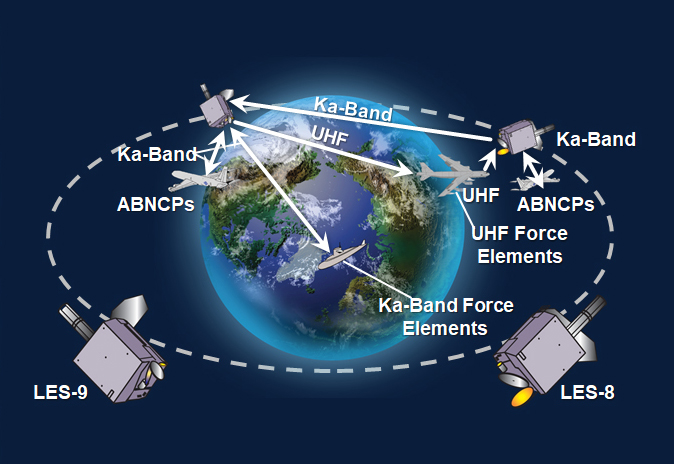
The receivers, transmitters, and antennas developed for this experiment were the first to operate at any frequency above 8 GHz for space-terrestrial communications. Onboard signal demodulation/remodulation and switching of digital streams on LES-8/9 further enhanced signaling robustness by removing uplink interference and noise that would waste a portion of downlink power in a typical transponder-based communications satellite.
Direct communications links, or crosslinks, between LES-8 and -9 significantly enhanced the physical robustness of the system. With crosslinks, the execution of a strategic communications scenario would not depend on the survivability of terrestrial relay facilities. The experiment's crosslinks were the first to have full duty cycle operation, digital implementation, and the multiplexing of several information streams. The Ka band was used for demonstrating this crosslink capability.
Large strategic force–element platforms, such as submarines, were envisioned to have mast- or periscope-mounted Ka-band terminals to receive force-direction messaging and to send report-back status. It was also recognized that more numerous airborne force elements such as strategic bombers would also benefit from Ka-Band links. However, changing these platforms from UHF systems with hemispherical antenna beams to Ka-band systems with directive antennas and associated pointing/tracking systems would be an expensive, time-consuming recapitalization that could potentially delay an earlier adoption of other beneficial portions of the LES-9 architecture.
To remain at UHF, these force elements leveraged the onboard signal processing features of LES-8/9 to digitally translate (or crossband) Ka-band command-center signals to/from UHF force-element links. New modems accommodating enhanced downlink UHF signaling to reject any space-borne interference and an innovative code-division multiple access (CDMA) uplink technique to efficiently handle a large number of asynchronous report-back messages significantly improved communications robustness, without requiring changes to the UHF radio-frequency infrastructure of these airborne force-element terminals.
Other satellite resiliency features included autonomous on-orbit operation utilizing a low drift-rate third-generation gyroscope from Draper Laboratory and a radiation-hard power source.
Lincoln Laboratory, the Air Force, and the Navy developed demonstration terminals to work with LES-8/9. Airborne demonstrations were conducted with an Air Force Research Laboratory (AFRL) aircraft. The aircraft had both Ka-band and UHF terminals, so it could emulate ABNCPs and both Ka-band and UHF–equipped force elements to experimentally evaluate the advantages of the new strategic communications concept and technologies.
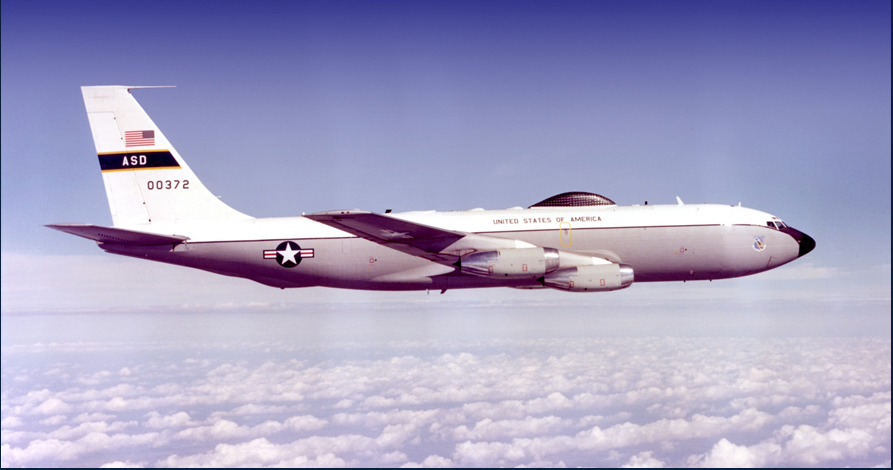
The LES-8/9 program also developed satellite control panels containing block diagrams of key spacecraft systems, with telemetry-driven LEDs to indicate the current status of switch settings and manual switches that an operator changed to generate spacecraft commands when a reconfiguration of the spacecraft was desired. These innovative human-interface panels allowed LES-8/9 communications configurations (or bus functions using a similar panel) to be rapidly established or changed without requiring staff to have extensive knowledge of the satellite's design. The viability of controlling a strategic communications scenario only from an ABNCP was demonstrated by connecting these control panels to terminals on the AFRL test aircraft and executing force-direction, command conferencing, and report-back functions while the controlling aircraft flew in the Arctic — a major demonstration of the robustness of the envisioned architecture.
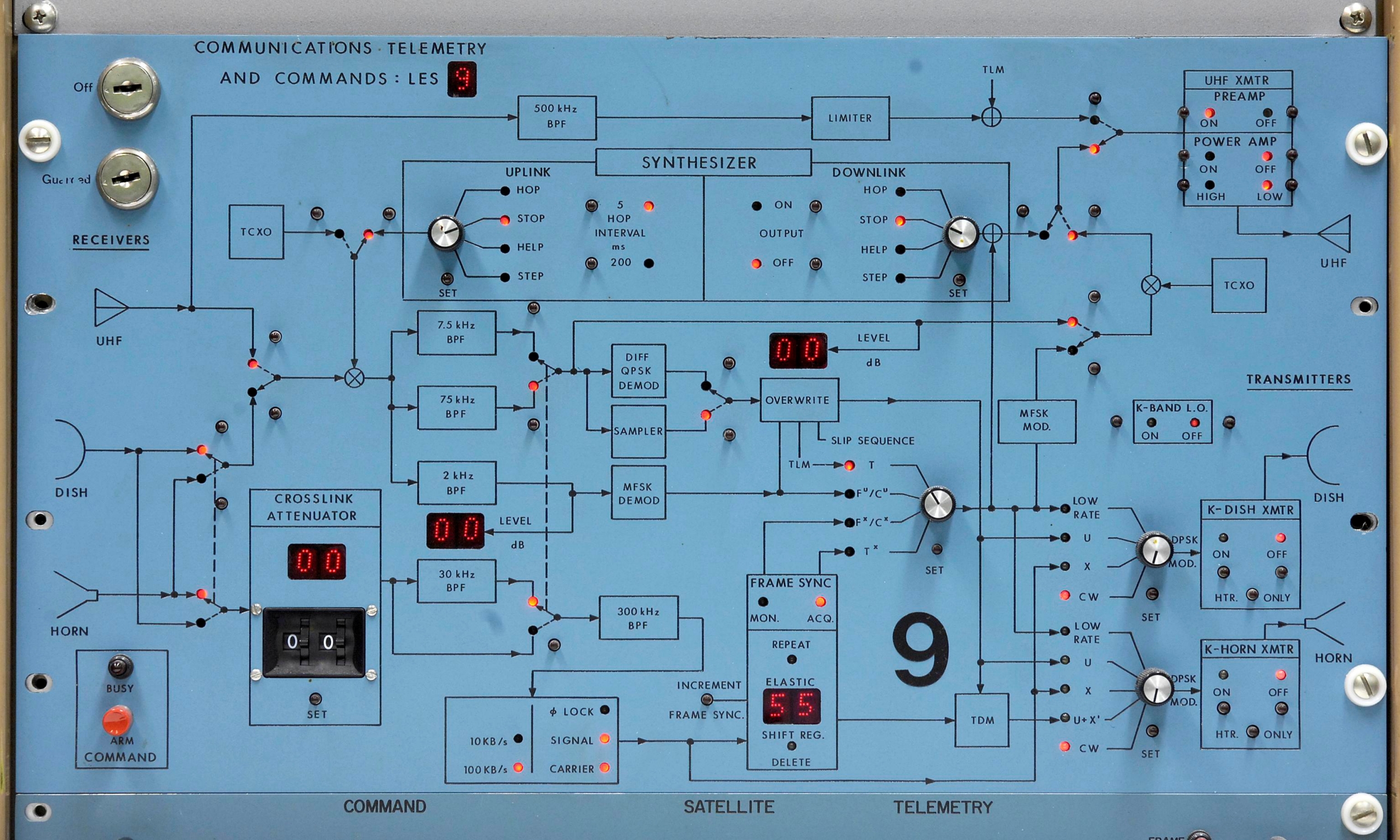
Impact on military and commercial SATCOM
LES-8/9 successfully demonstrated that six advanced technologies were ready for utilization in space environments, or, in other words, were at NASA's Technology Readiness Level 6 or above.
The use of wide-bandwidth allocations that were available at Ka-band frequencies and above was incorporated into generations of future military and commercial SATCOM systems to greatly expand capacity and robustness. LES-8/9's use of the 36 to 38 GHz were experimental Ka-Band allocations for demonstration purposes, since the radio frequency bands in these regions had not yet been assigned by U.S. and international agencies. Subsequently, both tactical and strategic military SATCOM employed allocated extremely high-frequency uplinks (around 44 GHz) and Ka-band downlinks (near 20 GHz), while commercial systems used Ka band for both links (uplinks near 30 GHz and downlinks near 20 GHz).
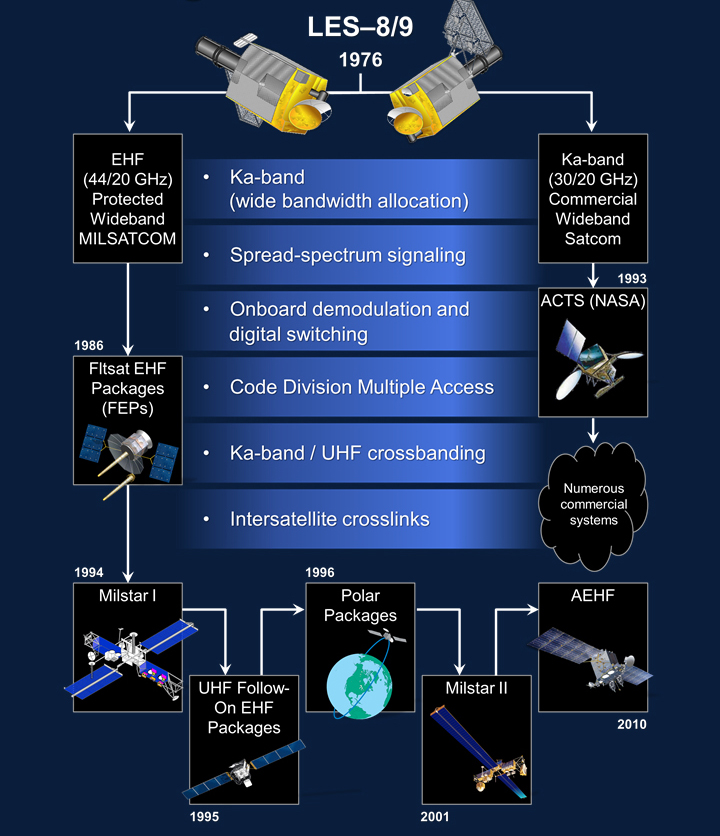
Onboard demodulation and digital switching were other dual-use technologies incorporated to reject uplink interference and enable flexible routing of traffic among multiple coverage areas. Similarly, multifrequency crossbanding further added flexibility to communications connectivity through both military and commercial SATCOM. Code-division multiple access allowed a large number of asynchronous, bursty-traffic users to more efficiently utilize bandwidth. (The LES-9 CDMA technique was developed from an academic study during the satellite's design. The principal investigators for that study later invented the CDMA cellular telephone standard.
Intersatellite crosslinks allowed extremely long-range connectivity without having to use multiple “hops" through ground relay points, avoiding signal delays associated with these extra hops and potential physical relay-site vulnerabilities in times of conflict. The spread-spectrum signaling was primarily leveraged for very high levels of interference rejection for strategic and tactical military SATCOM systems.
In all, LES-9 provided the path forward for generations of future strategic and tactical military SATCOM, including the Milstar and Advanced Extremely High Frequency systems in use today. The development of these systems proceeded with reduced risk thanks to the realistic environment in which LES-9 experiments were conducted and the subsequent technical advice and technology transfer provided by Lincoln Laboratory personnel. All but the spread-spectrum technologies were pertinent to future commercial SATCOM systems and influenced many of these systems, including NASA's Advanced Communications Technology Satellite program.
Satellite design
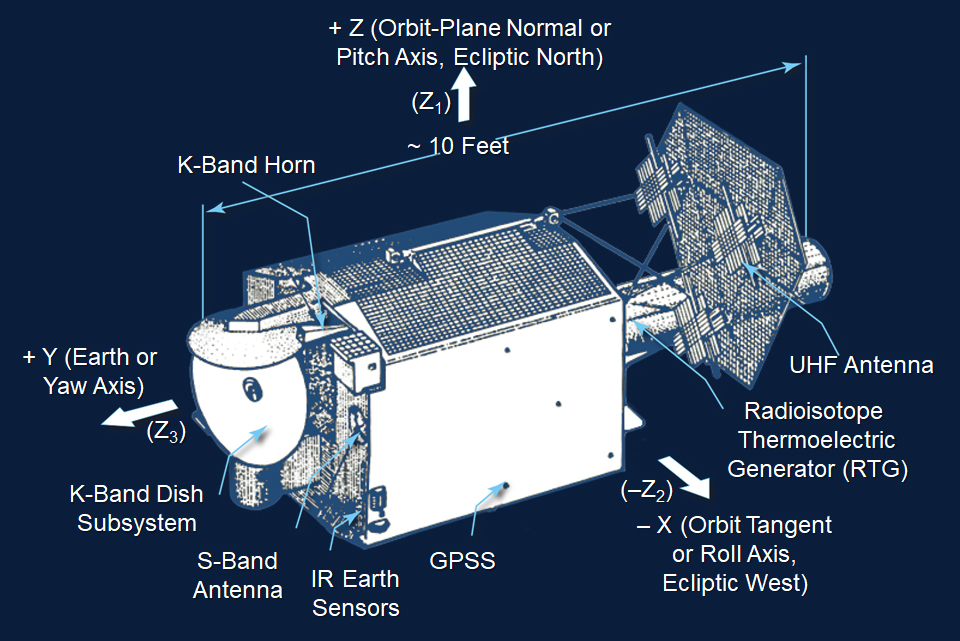
The structural configuration of the LES-9 satellite is shown in the figure above. LES-8 had a similar arrangement, except it was rolled 180 degrees around the Earth or yaw axis so that its crosslink antenna could point to LES-9. The satellite is a three-axis controlled platform, with a longest dimension of approximately 10 feet and a weight of about 1,000 pounds. The attitude-control system incorporates a gimballed momentum wheel, Earth and Sun sensors, and a gas-propulsion system to offload the momentum wheel and to enable changes in the stationkeeping location.
The Earth-facing end of the satellite contains an S-band antenna for command/telemetry, Ka-band horns for Earth coverage, and a Ka-band dish system to support communications at higher data rates for command-center conferencing to theater-size areas or to establish a crosslink to LES-8. The UHF antenna is an array of crossed dipoles over a ground plane mounted at the back of the satellite (as seen from the Earth).
Perhaps the most striking feature of LES-9's configuration is the lack of large arrays of solar cells to generate the vehicle's power. LES-9's source of electricity is a pair of radioisotope thermoelectric generators (RTGs), each producing about 155 watts at the beginning of life. The RTG is a cyclinder containing a large number of thermocouples generating electricity from the heat given off by ping-pong-ball-sized spheres that contain plutonium-238. The RTGs used on LES-8/9 were developed and fabricated by the Los Alamos Scientific Laboratory. These initial RTG models would later be used for several of NASA's Voyager deep-space probes starting in 1977. The procedures developed to ensure the safety of the LES-8/9 team and the environment from exposure to radioactive materials in the RTGs informed the Voyager team's efforts.
Unexpected influences
LES-9's influence extended far beyond the successful demonstration of a robust architecture for military communications satellites. Because of the satellite's reconfigurable communications features, its incorporation of higher frequencies, and its inclined, synchronous-altitude orbit, applications arose that were not envisioned during the design and implementation phases of the new architecture.

One of these unexpected contributions was to the performance of radio-astronomy telescopes. These telescopes' antennas must have highly accurate reflective surfaces to perform well; the Ka-band downlink from LES-9 provided a short-wavelength signal that enabled high-resolution holographic measurements to be taken of the antenna's reflector shape. These measurements allowed engineers to accurately adjust the antenna's shape to be as close as possible to an ideal parabola in large radio-astronomy telescopes, such as the Heinrich Hertz Submillimeter Telescope in Tucson, Arizona.
LES-9 also was useful for geolocating sources of RF interference generated by unknown transmitters. To locate sources of RF interference, scientists use differential time-of-arrival and Doppler-shift measurements. If the satellites used for such measurements are geostationary, at least two satellites are usually required to get sufficiently different differential measurements. However, LES-9 wasn't geostationary — its inclined orbit resulted in a figure-eight subsatellite point versus a single stationary location over a particular longitude on the equator. Because of the motion of LES-9 with respect to an Earth-based interference source, measurements from one satellite at two (or more) different times gave very good results.
Another contribution enabled by LES-9's inclined synchronous-altitude orbit was multiple-hour-per-day coverage of high-latitude locations. During the summer of 1994, LES-9 provided reliable communications support to a Coast Guard voyage over the North Pole. For years, the National Science Foundation scheduled daily access time on LES-9 for connectivity to their personnel stationed in Antarctica. This satellite carried much of the critical email traffic between the contiguous United States and the South Pole for the long-distance medical treatment of Dr. Jerri Nielsen prior to seasonal conditions improving so that she could be evacuated on October 15, 1999.
LES-9 has also been incorporated into some of the Laboratory's outreach activities, including for demonstrations during open houses and for experiments by students developing software radios.
A timely response to a UHF service need

Several configurable modes of UHF communications that were compatible with the large number of existing UHF SATCOM terminals were included in the LES-8/9 satellites. These configurable modes provided residual capabilities once the demonstration of the new architecture and enabling technologies was complete. Ka-band SATCOM service in the program's experimental frequency allocation of 36 to 38 GHz was not expected to continue in the long term once the spectrum-allocation community addressed designating SATCOM bands for operational systems in the Ka-band and above.
One important benefit of planning for UHF residual capabilities on LES-8/9 arose as a critical need for additional SATCOM service developed during the build up of U.S. forces in the Middle East as part of the preparations for the Desert Storm operation to liberate Kuwait. At the request of the Joint Chiefs of Staff, Lincoln Laboratory performed an emergency, accelerated repositioning of LES-9 in order for the satellite's field of view to include the anticipated Desert Storm operating area. The Joint Staff awarded a plaque to the Lincoln Experimental Satellite Operations Center in February 1991 for their outstanding response to the request for SATCOM support.
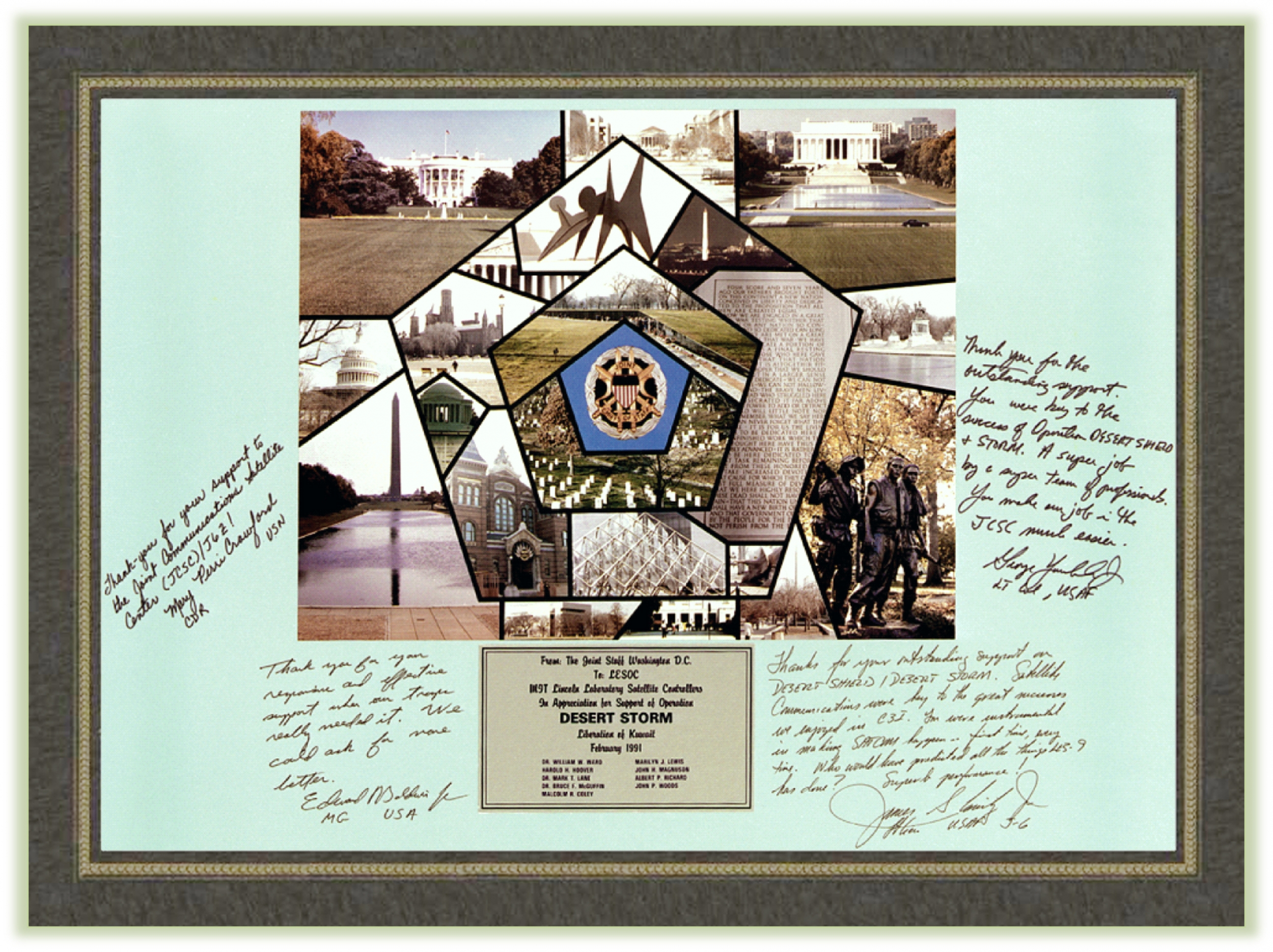
A satellite made to last
During the time of the LES program, there was not a large, established base of technology that had been qualified for use in space. Accordingly, the program used the following four approaches to increase the likelihood that its experimental communications satellites would be successful:
- Innovative system designs, but careful selection of components and conservative operating points well within the range supported by the devices. The team often conducted irradiation testing of candidate components to verify that they could withstand the intended space environment.
- Principal engineers for each subsystem who were responsible for their unit(s) for the entirety of the program (i.e., throughout the design, implementation, and pre-and post-launch test and demonstration phases).
- Extensive prelaunch testing to identify and replace components subject to early failure or to verify workmanship.
- Aggressive pursuit of test anomalies to determine root cause and any corrective actions in design, implementation, or test configurations. No matter how small, every unexpected result was addressed.
Owing to these principles, LES-9 went on to become the longest continuously operating communications satellite in U.S. history — at 44 years and 67 days. The typical lifetime of a 1970s satellite was just five to ten years.
For 28 years, LES-8 joined its partner in performing many validating architectural concept and technology-maturity demonstrations as well as a broad portfolio of services until its decommissioning in 2004.
During the first quarter of 2020, LES-9's subsystem that gathered satellite status information and modulated the primary S-band telemetry carrier ceased to operate. The vehicle remained stable and retained its station-keeping, attitude control, power management, UHF transponded communications, and commanding functions. Efforts to restore telemetry were unsuccessful. On May 20, 2020, LES-9 was deactivated.
Its outstanding legacy of service to the nation is quite a tribute to the vision, skill, and dedication of the LES-9 team.